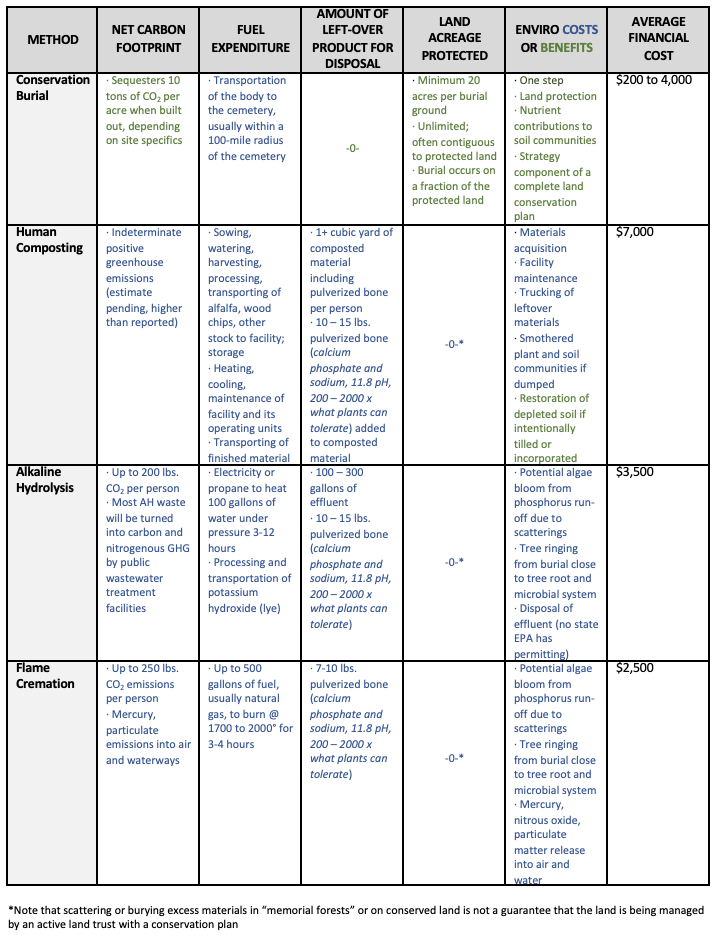The Disposition Debate
While the Conservation Burial Alliance is focussed on promoting conservation level natural burial, we are frequently asked to weigh in on how other disposition methods stack up to natural burial. Over the past few years, we have all experienced a welcome onslaught of media articles that reflect a growing public interest in finding environmentally responsible exit plans. We can't ignore that some of what has been reported conflates cremation processes with ground burial, causing confusion and sometimes inadvertently shielding the scientific facts. Part of our mission is to protect the environment through providing responsible after-death choices and to educate the public to both conflicts and opportunities. In keeping with that mission, we have gathered the facts regarding various methods in one place for easy comparison.
Defining Natural BurialNatural burial is literally a body buried directly in the ground. It requires a full body buried 3.5 - 4 feet deep without vaults and non-biodegradable containers. Natural burial requires no other steps, no other natural resource expenditures.
How this is accomplished is where we see variation. Some burial spaces are government or faith community operated. Some are non-profit and some for-profit. Some are located in urban areas, many suburban and rural. Some partner with conservation entities and land trusts, and some follow best practices with or without applying for certification. Some use amendments to optimize decomposition. What they all have in common is the practice of direct earth burial without impediment. But natural burial grounds are also being asked to bury remains left over from cremation processes. Some accept leftover remains from cremation processes as a courtesy to families, some decline in deference to concerns over soil health and the use of natural resources used in the cremation processes. Our concern is simple: that the public understand that natural burial—and conservation burial specifically—protects and restores intrinsically valuable land while serving individuals and communities, all by reducing or eliminating use of precious water reserves, toxic chemicals, oil and gas, or other valuable resources. [Learn more about natural and conservation burial in our video, Deeply Rooted, and The Natural Burial Experience] |
Defining CremationWhile flame cremation has been gaining popularity over the past decades, two other processes have gained attention as their technology has improved. What consumers need to understand is that all three—flame cremation, alkaline hydrolysis, natural organic reduction or human composting—are permitted in states that have passed measures to make them legal by establishing and expanding the definition of cremation.
Why? Because these options all require either use of industrial processes that have the potential for impacting public services or use of natural resources that have the potential to impact public health and safety. They also result in a secondary waste product that must be disposed of, creating both potential burden for taxpayers and local environmental impact. Because these processes reduce the body to basic elements such as sodium and calcium phosphate, the State closely regulates them to ensure that cause of death is established, requiring additional protective steps. Calling any cremation remains disposal natural burial is fundamentally incorrect. While one cremation process may use fewer resources than another cremation process, all rely on the use of one or more resources. None of them fit the definition of natural burial. [See Burying Cremated Remains for more information about disposal options and Cremation Curious that explains the legal and environmental issues surrounding cremation processes] |
Environmental Comparison of Disposition Options
For the full text of the article, go to Taking a Closer Look at Carbon Footprints by Billy Campbell and Lee Webster
Historically, we have burned heretics and buried saints."
— Amy Cunningham


